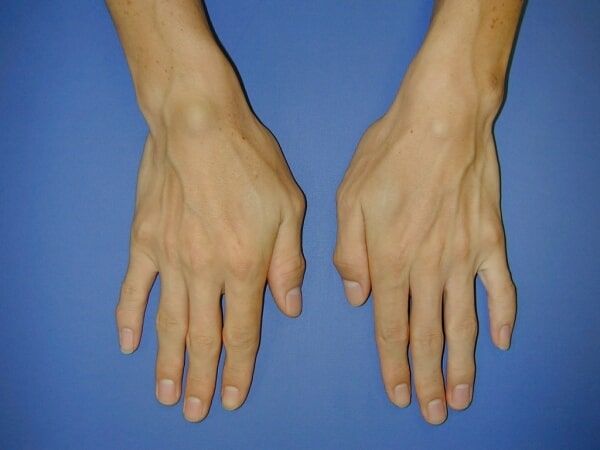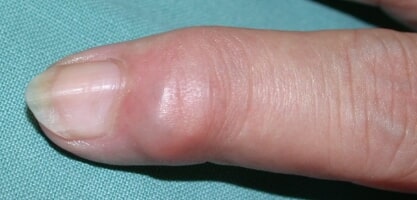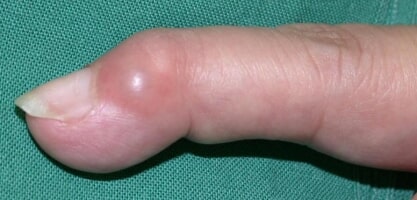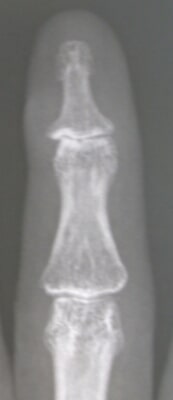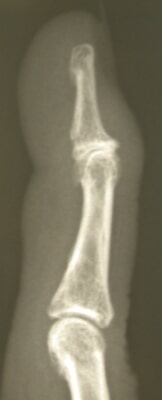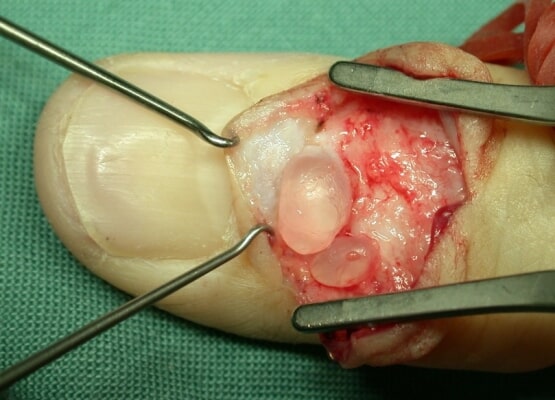Ganglia of the Hand
A ganglion is a cyst filled with a jelly-like substance, which is concentrated synovial fluid. Fluid from the joint escapes due to degeneration or minor injuries of the ligament and capsule, resulting in a cyst. It is formed in close relation to a joint or tendon sheath (the tunnel surrounding the flexor tendons of the finger) and appears as a lump over these regions. The common sites of ganglia (plural form of ganglion) formation are the back part of the wrist joint, front part of the wrist, small joints of the fingers, and the palmar aspect of the finger and hand along the tendons.
The commonest site for ganglion cyst formation is the back part of the wrist joint. It may be precipitated by a sprain, or not related to any trauma at all. There is usually pain as the ganglion enlarges. The cyst may shrink or enlarge at different times, and occasionally disappear. It usually does not cause any pain.
|
|
|
Osteoarthritis, especially of the joints near the fingertip, may result in ganglion formation. Ganglia here usually enlarge causing the skin to thin out, making the cysts appear bluish and shiny. Occasionally, the skin may break causing the jelly-like fluid to escape, and risking infection of the joint.
|
|
|
| Ganglion cyst of the distal interphalangeal joint related to osteoarthritis. | |
|
|
|
| Osteoarthritis of the distal interaphalangeal joint. | |
Clinically, the cysts may be very tense and even seem bony to touch, although some are softer. Most ganglia are non-tender. Instability of the ligaments and osteoarthritis need to be excluded.
Investigations are often required. X-rays are used to check for osteoarthritis. Ultrasound or magnetic resonance imaging (MRI) are sometimes needed to diagnose deeper ganglion cysts. Ligament injuries can also be seen on MRI.
Treatment of ganglion cysts depend on the cause and symptoms. Traditionally, they are given the “Bible treatment”, where the heavy family Bible is used to smash and break the ganglion. This causes pain, and the recurrence rate is very high. Ganglia of the wrist may be left alone if there are no symptoms of pain or discomfort. Alternatively, they may be surgically removed, but there is a recurrence rate of 10-15%. It is necessary to trace the cyst into the joint to ensure complete removal, and reduce the risk of recurrence.
Ganglion cysts of the hand related to fingertip joint osteoarthritis (also called mucous cysts) can cause deformity of the nails due to pressure on the nailbed. Excision of this kind of cyst is recommended to correct the nail deformity, and to prevent breakdown of the skin. Sometimes skin from the surround region needs to be turned around to cover the defect after excision. In severe osteoarthritis, fusion of the joint will need to be done to treat the pain and deformity associated with the osteoarthritis.
|
|
|
| Intra-operative appearance of a ganglion cyst | |
A ganglion cyst of the tendon sheath appears as a little bead on the palm of the hand at the base of the finger. It is usually painless, but may cause irritation when the hand is gripping something. It may be excised with a cuff of the tendon sheath if it enlarges, or causes irritation.



